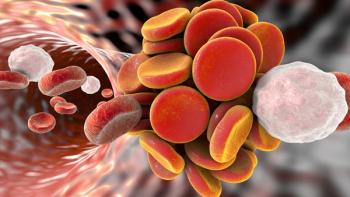
Belantamab Exhibits Rapid/Prolonged Plasmablast Cell Reduction in Myeloma
No TRAEs leading to dose discontinuation, DLTs, or belantamab-related corneal events above grade 1 occurred with belantamab in multiple myeloma.
Belantamab exhibited rapid and prolonged reduction of plasmablast cells across multiple dose levels in the absence of a monomethyl auristatin F payload when used as a treatment for patients with multiple myeloma, according to findings from a planned analysis of belantamab dose escalation in part 1 of the phase 1/2 DREAMM-20 trial (NCT05714839) presented at
Data revealed that plasmablast levels were reduced by almost 100% following the initial dose for all evaluable patients (n = 5) in the 900- and 2000-mg cohorts. Additionally, 4 of 5 patients maintained this level, displaying mechanism of action activity at these dose levels. Moreover, no patients treated with 300 mg of belantamab were evaluable for plasmablast level reduction.
Additionally, in 18 patients treated across the 300-mg (n = 6), 900-mg (n = 6), and 2000-mg dose levels (n = 6), 5 had responded for a confirmed overall response rate of 28% (95% CI, 9.7%-53.5%). Additionally, among 5 responders, 3 had ongoing responses as of the data cutoff date; 1 patient discontinued due to disease progression after a 13-month duration of response (DOR), and the longest DOR was 534 days. An additional 5 patients exhibited stable disease as best response, with 10 patients achieving disease control with belantamab for a disease control rate of 56%.
“Belantamab demonstrated promising single-agent activity and a favorable safety profile, with no dose-limiting toxicities, treatment-related adverse events [TRAEs] leading to discontinuation, or belantamab-related grade [2 or higher] corneal events. Ocular events were incidental findings and not related to belantamab,” Hang Quach, MD, MBBS, FRACP, FRCPA, professor of hematology at the University of Melbourne and departmental head of clinical hematology and clinical hematology research at St Vincent’s Hospital Melbourne, said in the presentation on the study findings. “Promising preliminary clinical activity was observed, with durable responses reported across dose levels in this difficult-to-treat triple class–exposed/refractory population.”
Patients 18 years or older with histologically or cytologically confirmed multiple myeloma who received at least 3 prior lines of therapy, including an immunomodulatory agent, proteasome inhibitor, and an anti-CD38 monoclonal antibody, and an ECOG performance status of 0 to 2 were assigned to receive escalating doses of belantamab on days 1 and 15 of each 28-day cycle. Treatment continued until disease progression, and patients who experienced relapse with belantamab had the option to be treated with belantamab mafodotin-blmf (Blenrep) in the part 1b portion of the trial. The data cutoff date was February 22, 2025.
The DREAMM-20 study sought to assess the safety, tolerability, and clinical activity of an unconjugated belantamab antibody in the aforementioned patient populations.
Among the 18 patients treated in the study, 50% were women and the median age was 76.0 years (range, 42-86). Patients primarily had International Staging System stage I disease (50%), an absence of extramedullary disease (83%), and high-risk cytogenetics (56%). The median number of prior lines of therapy was 4.5 (range, 3-18), 94% of patients had triple class–exposed disease, and 6% had penta-refractory disease.
The overall median duration of belantamab exposure was 63.5 days (range, 15-619), and a relative dose intensity of 99% was given to patients across all dose levels.
Any-grade AEs occurred in 94% of patients, including 100%, 100%, and 83% of the 300-mg, 900-mg, and 2000-mg dose levels, respectively. Grade 3 or higher AEs occurred in 72% of patients, including 83%, 67%, and 67% at the respective dose levels. Furthermore, TRAEs occurred at a rate of 67% in the total population as well as in 50%, 83%, and 67% of each dose level.
The most common TRAEs that occurred across all dose levels included infusion-related reactions (22%), neutrophil count decrease (22%), anemia (17%), blurry vision (11%), and platelet count decrease (11%). Additionally, the most common grade 3 or higher AEs included neutrophil count decrease and anemia (both 22%). In total, 6 serious AEs occurred, with 1 related to treatment in the 2000-mg cohort; no fatal AEs were reported.
Reference
Quach H, Augustson B, Barton L, et al. Belantamab for the treatment of multiple myeloma: results from part 1 of the first-in-human phase 1/2 DREAMM-20 trial. Abstract presented at: 22nd International Myeloma Society Annual Meeting; September 17-20, 2025; Toronto, ON, Canada. Abstract OA-56.
Newsletter
Stay up to date on recent advances in the multidisciplinary approach to cancer.













































































